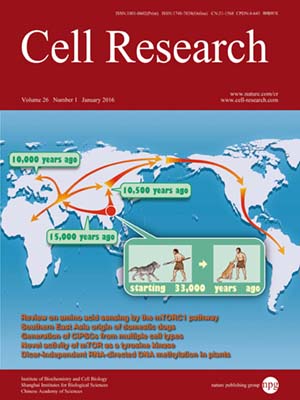
Volume 26, No 1, Jan 2016
ISSN: 1001-0602
EISSN: 1748-7838 2018
impact factor 17.848*
(Clarivate Analytics, 2019)
Volume 26 Issue 1, January 2016: 131-134
LETTERS TO THE EDITOR
Parthenogenetic haploid embryonic stem cells efficiently support mouse generation by oocyte injection
Cuiqing Zhong1,2,3,*, Zhenfei Xie1,2,3,*, Qi Yin1,2,3,*, Rui Dong3,4, Suming Yang1,2,3, Yuxuan Wu1,2, Li Yang4 and Jinsong Li1,2
1Group of Epigenetic Reprogramming, State Key Laboratory of Cell Biology, Institute of Biochemistry and Cell Biology, Shanghai Institutes for Biological Sciences, Chinese Academy of Sciences, Shanghai 200031, China
2Shanghai Key Laboratory of Molecular Andrology, Institute of Biochemistry and Cell Biology, Shanghai Institutes for Biological Sciences, Chinese Academy of Sciences, Shanghai 200031, China
3University of Chinese Academy of Sciences, Beijing 100049, China
4Key Laboratory of Computational Biology, CAS-MPG Partner Institute for Computational Biology; CAS Center for Excellence in Brain Science, Shanghai Institutes for Biological Sciences, Chinese Academy of Sciences, Shanghai 200031, China
Correspondence: jsli@sibcb.ac.cn
Mammalian haploid embryonic stem cells (haESCs) have been recently generated from parthenogenetic and androgenetic embryos1,2. Both parthenogenetic haESCs (PG-haESCs) and androgenetic haESCs (AG-haESCs) can be used for cell-based reverse and forward genetic screens on a whole-genome scale3,4. AG-haESCs, after intracytoplasmic injection into oocytes (referred to as ICAHCI), can be used as a sperm replacement to produce healthy semi-cloned (SC) mice at a rate of ~2% of transferred embryos5,6.
10.1038/cr.2015.132
FULL TEXT | PDF
Browse 3339


